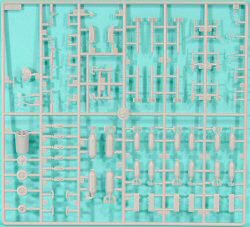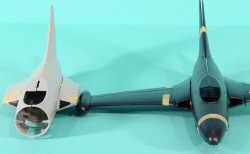
Hobbycraft 1/48 F9F-2/-3 International Cat Kit First Look
By Michael Benolkin
| Date of Review | December 2006 | Manufacturer | Hobbycraft |
|---|---|---|---|
| Subject | F9F-2/-3 International Cat | Scale | 1/48 |
| Kit Number | HC1456 | Primary Media | Styrene |
| Pros | Simple build, positionable wing fold, flaps, lots of armament | Cons | |
| Skill Level | Basic | MSRP (USD) | $24.98 |
First Look
 |
 |
 |
 |
 |
 |
 |
Editor Note: This preview has been updated to show the box art and decal information, courtesy of Hobbycraft Canada.
Some time ago, we heard that Hobbycraft Canada was planning a release of the Grumman F9F-2 Panther in 1/48 scale. Later we learned that Trumpeter was also releasing an F9F-2. There was some conjecture that Trumpeter was doing a competing release, but as the dust settles, we have learned that the Hobbycraft and Trumpeter Panthers are one in the same tooling - a collaborative effort.
Part of the delay has been to try to get the best tooling possible - they wanted to get this one right. It looks like the effort paid off.
Note: You may have seen photos of a build-up of this kit out on the net and it looked like the model had (among other things) a big bubble canopy. It is likely that this was a build-up of an earlier test shot of this kit because many of the concerns I had with this release went away when I received this test shot, courtesy of Hobbycraft Canada.
Note: This is still a test shot, albeit one of the latest, but what you see here may still change by the time the kit hits the streets in early 2007.
So what do we have here? The Panther kit is presented on three parts trees molded in light gray styrene. A fourth tree contains the windscreen, canopy, and other clear parts. I've imaged the first two trees front and back for your inspection. Let me apologize about the wing tree - I had the parts in-hand with 'Corky' Meyer's F9F Panther Part One (Naval Fighters #59, Ginter Books) and diverted to my work bench. I started through the list of things I thought I'd seen in that build-up photo and compared the sprues to the photos in the book. Then I had the Monogram F9F-5 out on the bench and was doing some eyeballing of the similarities and differences. Before I knew it, I was starting to assemble both kits with Tamiya tape to do a proper three-dimensional comparison before I remembered I hadn't even photographed the bloody sprues! Fortunately I had only pulled three parts off the Hobbycraft/Trumpeter trees for the inboard wing section.
So what did I find out? First, the kit is beautifully done and tapes together nicely. The wing/fuselage fit is nice even with tape!
I saw some concern over the intakes being too small being expressed on some of the message boards. The lower edge of the of the intake should be more parallel with the underside of that section of wing as is the top edge. That would carry the opening of the intake out a little further. As I said earlier, this is still a test shot and there may be changes, but even if it doesn't, you have two choices:
- Take 30 seconds with a file and adjust the shape of the intake yourself
- Cut away the intakes back about 1/4 inch and graft on the intakes from the Monogram kit
According to Corky Meyer, the F9F-2s were retrofitted with the same intake/wing fence arrangement as the F9F-5 as it reduced the approach speed of the modified aircraft by 13 mph - a good thing when landing on the carrier! Check your references to see which intake arrangement was on the F9F-2 you're modeling.
The fuselage halves of the F9F-2 and F9F-5 kits align rather nicely which highlighted the only major shape difference - the height of the vertical stabilizer which was correctly shorter on the F9F-2 and looks good against the photos and drawings in the book. You can see in the image above how the two partially assembled fuselages compare as well. The nose of the F9F-2 is molded separately and as you can see in the first two parts photos, the gun nose and photo nose variants are there. I don't know if both will be provided in the production release of the kit, but you can see the layout here.
The other area of interest was the windscreen and canopy. That photo on the net gave the impression of a big honking bubble canopy, but not so. You can see here that the canopy is properly profiled and aligns nicely with the windscreen. When compared to the Monogram canopy, the shape difference is instantly visible as is the thickness of the Monogram canopy. The Monogram parts each have one of the molding tabs still present so you could tell them from the Hobbycraft/Trumpeter parts. Kudos to the Hobbycraft/Trumpeter team on the canopy.
The windscreen comparison was far more interesting. When comparing the Hobbycraft/Trumpeter and Monogram windscreens to the photos in Corky's book, the Monogram windscreen is WAY off. It is too short from front to canopy bow. It shouldn't arc up at the front either. In the grand scheme of things, this would be classified as a nit.
The Hobbycraft/Trumpeter windscreen gets the shape and proportions right from what I can glean from the photos. I might retrofit my Monogram F9F-5 with one of these windscreens. The only glitch I could find was simply where the top of the flat plate glass panel frame terminates. It should terminate directly into the canopy bow, but it comes just short of the bow and a small frame connector links the glass panel frame to the canopy bow, MiG-style. You REALLY have to dig to see this minor glitch.
No instructions or decals came with this test shot as they will differ between the Hobbycraft and Trumpeter boxings anyway. What these releases will have in common are a nice selection of bombs and HVAR rockets for underwing stores, the option of folded or flight-positioned wings, positionable wing flaps, and positionable canopy. The intakes do feature separately molded intake trunks.
I noted in one of Corky's reviews of another F9F-2 kit that it had an F9F-5 cockpit tub as the F9F-2 had 'stepped' side consoles whereas the F9F-5's consoles were flat. This kit features the proper 'stepped' consoles.
If you haven't read any of the Ginter Books' series on the Panther/Cougar, you might ask who Corwin 'Corky' Meyer is to have an opinion on the Panther. If anyone is qualified to speak on the aircraft it would indeed be the man who first flew the aircraft and continued to flight test the various updates to the airframe as Grumman's chief test pilot.
In this release, Hobbycraft has provided markings for five aircraft:
- F9F-2, 123564, VF-61, C/203, USN
- XF9F-2, 122475, Grumman
- XF9F-3, 122476, Grumman
- F9F-2, 0418, 3-A-103, Argentine Navy
- F9F-2, 123655, VF-721, A/116, USN
Overall, this looks like it will be a simple build and the fit of the parts I test-fitted was excellent, especially at the wing roots. Look for a number of decal options from both manufacturers as well as from the aftermarket sector as well. This should be a popular kit when it hits the streets and if the final version builds as nicely as this one, I'll be stacking a several up in my own collection!
For a look at how the model goes together, look here.
My sincere thanks to Hobbycraft Canada for this sneak peek!














